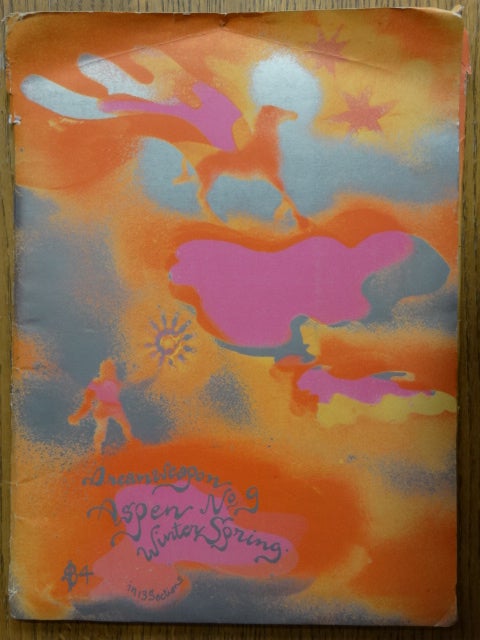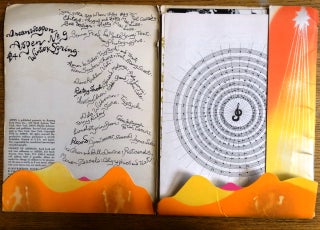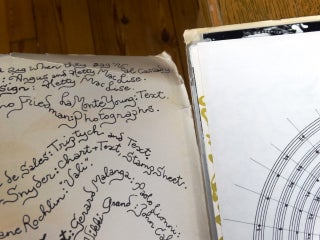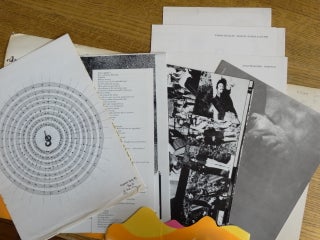Aspen No. 9: Dream Weapon (Winter/Spring)
New York: Roaring Fork Press, 1970. Original. Folio. Neon orange, silver, and hot pink illustrated card folio with scalloped inner pockets; silver script lettering on cover. Contents include 10 of the 13 original sections. Each section in a different format on some kind of paper/card. Contents VG+-NF but for chipping and age toning to the very the bottom edge of Section 10 (a single sheet). / Folio poor with wrinkled corners and top edge, tears to head/tail of spine, and general wear otherwise. Folio still, however, complete and would look great framed with all the wrinkles flattened. Content missing sections 2 (45 rpm record, Spontaneous Sound: Joyous Lake; and Ira Cohen and Bill Devore: Postcards). Item #153704
"The first three-dimensional Magazine in a Box, Aspen was brought to life by Phyllis Johnson, a former editor at Women’s Wear Daily and Advertising Age, while on vacation in the ski resort town of Aspen, Colorado in 1965. Because it came in a box, as its publisher explained to subscribers in the first issue, the magazine didn’t need to be “restricted to a bunch of pages stapled together,” but could include anything from “blueprints, a bit of rock, wildflower seeds, tea samples” to “an opera libretti, old newspapers and jigsaw puzzles.” Published on an irregular schedule between 1965 and 1971 and issued in a laminated custom-made cardboard box filled with flyers, phonograph records, Super-8 films, prints and postcards, the concept behind Aspen’s avant-garde spirit was that of a multimedia magazine dedicated to covering “culture along with play”. As a response to the restrictive industry format, each issue was overseen by a different editor and designer and devoted to different topics – as its founder once said, it was conceived to become “a time capsule of a certain period, point of view or person”. With ten issues published over six years, Aspen’s life was short but culturally meaningful. Counting contributions by some of the most prolific artists of the century – including Peter Blake, Ossie Clark, Marcel Duchamp, David Hockney, John Lennon and Lou Reed – Aspen was a marvel of creative journalism. Due to the inconsistency between issues, the magazine was deprived of its second-class mail license and forced to fold by the US Postal Service in 1971. This issue is known as The Psychedelic Issue. Titled Dreamweapon, issue 9 was released in 1971 and was devoted to the art and literature during the psychedelic drug movement. It featured a hallucinogenic cover designed by Hetty MacLise who, together with husband, original Velvet Underground drummer Angus MacLise, also curated the design of the whole issue. Inspired by the acid trip tickets presented by Warhol in issue 3, Dreamweapon explored the wilderness of those years. From the words “Lucifer, Lucifer, Bringer of Light” printed on the back of the cover to Neal Cassady’s quote “You gotta zig when they zag” written on the inside of the box, the issue enclosed devilish images such as Dale Wilbourn’s drawing Triptych, alongside poems like Vali Myers’s letter to friends Diane and Shelley, accompanied by photographs by Diane Rochlin. Psychedelic influences in music were explored through spur-of-the-moment recordings like Spontaneous Sound and Aymon de Sales’ illustrated Musical Scores and Glyphs. Psychedelic art was also included in the form of Benno Friedman’s chemically stained frames from classic Western movies and Don Snyder’s Lumagraphs, a gummed stamp sheet of female nudes. Possibly the most fascinating of all, the Psychedelic issue surely scored the high point of Aspen’s implausible and boundless spirit.
Sorry, this book is not available.
Notify me when this comes back in stock.





